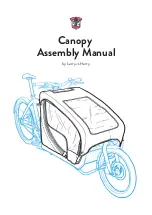
10
10
10
10
10
Features
The R32 suspension system has more benefits than just the com-
fort of the cushioned ride. Up until now, it was often difficult to
transport recumbents that did not have wheelbase lengths that
were the same as typical upright bikes. Tandem racks often were
needed. The R32 has the ability to fold itself into two positions;
fully folded, with the rear wheel tucked under the frame for a
"minimized" storage size, and partially folded, setting the wheel-
base to a typical 36", so transport on a standard car top carrier
(fork clamp style) is a snap.
System Pre-Load
To have the rear suspension operate efficiently, you need to set
the "pre-load" on the air shock to suit your weight. This is very
easy to do. Simply use a shock pump (a very high pressure pump
designed for suspension systems) to set the air pressure in the
rear shock. The exact air pressure needed depends on your size
(i.e. the seat position) and your riding style. You should start by
setting the shock to a pressure equal to your body weight. You
might need to run 40-60 psi over your body weight. If you want a
softer rider, reduce the air pressure. If you are getting excessive
"pogo-ing" on climbs, increase the air pressure.
R
R
R
R
Rear Suspension
ear Suspension
ear Suspension
ear Suspension
ear Suspension
15
15
15
15
15
ternal hub into the first gear position
("1" on the twist grip).
Now,
without
pedaling, twist the right
shifter back to the "#7" position, and
the left shifter to the #3 position. This
will slack up both cables. You will now
be able to pull the rear derailleur and
internal hub casings free from their cas-
ing stops on the right side of the frame,
just behind the crankset (Fig. 1)
You will need to pop the front brake
open at the caliper. (Fig 2)
Now, loosen up the riser clamp bolt
with a 5mm hex wrench. (Fig 3)
You should be able to pull the grey
handlebar riser free from the fork
steerer now. You can lay the riser along
the frame of the bike, and tie it in place
with bungee cords. Be careful not to
damage the gear or brake control
cables.
To re-install the handlebars, lift the
riser into place and slide it fully down
the fork steerer. Align the handlbars so they are perpendicular to
the front wheel, and firmly tighten the riser clamp bolt. Re-attach
the front brake cable at the brake caliper, and then pop the two
gear control cables back into their casing stops. Make sure both
the twist grip controls are set to the #1 position.You might have
to manually push the rear derailleur over until it's under the larg-
est cog to get enough slack in the system to get the casing back
into it's stop. Lift the rear wheel from the ground and lightly pedal
the cranks around a few times to get the gears re-settled.
Fig 2
Fig 3
Fig 1
T
T
T
T
Trrrrranspor
anspor
anspor
anspor
ansport & Stor
t & Stor
t & Stor
t & Stor
t & Stora
aa
aag
gg
gge
ee
ee






























